
 SEALIFT
SEALIFT
Seabased Logistics 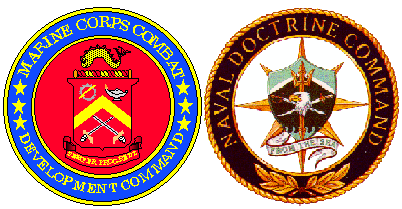
Forward...from the Sea, and Operational Maneuver from the Sea chart the direction for Naval Forces of the 21st Century. They collectively envision seabased power projection that employs naval maneuver, precision strike, superior situational awareness and protection, and focused sustainment. Seabased Logistics is a bold proposal to move toward more fully integrated operations, logistics, and information warfighting capabilities. It offers a conceptual framework, baseline operating tenets, and future operational capabilities to enable naval power projection...from the sea. Seabased Logistics is part of an on-going process to open debate and provide alternatives for future analysis, wargaming and experimentation. |
|
J.E. Rhodes Lieutenant General, U.S. Marine Corps Commanding General Marine Corps Combat Development Command |
G.S. Holder Rear Admiral, U.S. Navy Commander Naval Doctrine Command |
CONCEPT OVERVIEW
This concept describes the operational and tactical sustainment of forces operating on and from the sea. It is a concept to support forces that are naval in character but trained, organized and equipped to operate as an integral part of a Joint Force. The concept describes a means to support littoral power projection from over the horizon, independent of sovereignty restrictions and overseas basing requirements.
Our naval forces remain a primary instrument of National will to project power, protect interests, promote peace, and provide humanitarian relief. They operate in an increasingly unstable world where regional tensions have been liberated from the restraining influences of the bi-polar Cold War era. As sophisticated weapons proliferate in this environment, stationary forces and forward lodgments will become more vulnerable. The future battlefield will be characterized by coordinated speed of maneuver, increased operating ranges, and precision delivery of massed effects. Seabased Logistics offers the unique capability to both sustain the future high optempo battlefield and exploit the advantages inherent in mobility and over the horizon standoff.
Seabased Logistics proposes methods to support a full spectrum of littoral operations that directly and decisively influence events. It outlines implementing capabilities for Operational Maneuver from the Sea while retaining joint interoperability. Limited seabasing is currently embedded in Naval doctrine and actual practice. This concept embraces best existing and emerging commercial processes to expand the range, speed, and magnitude of tactical and operational sustainment. A primary enabler will be the coupling of seabased ship to objective distribution with network-based, automated logistics information to provide in-stride sustainment for maneuvering and fighting naval expeditionary forces. Seabased Logistics must be flexible and suitably robust to overcome asymmetric and challenging operational environments.
Seabased Logistics requires implementation of five fundamental tenets in how we operate and provide sustainment. The first will be operating from a base at sea vice establishing shore- based operations. The second is refining our operational and logistics posture to improve efficiency. The third will be implementing in-stride sustainment. The fourth will be integration with joint theater logistics. The last derives from the others: building and reconstituting combat power at sea.
|
The Tenets of Seabased Logistics
|
NEW POSSIBILITIES FOR OPERATIONS
The tradition of self-sustaining Naval Forces will expand to include support of Naval Forces operating further inland. By providing sustainment to operating forces ashore directly from an over the horizon base at sea, Seabased Logistics will allow the vision of Operational Maneuver from the Sea (OMFTS) and Ship to Objective Maneuver (STOM) to become reality. By operating from ships, the logistics base will maneuver with seabased maneuver forces and support sustained operations while on station. Employing ship to objective logistics will reduce or eliminate lodgments on the beach with their attendant operational pause and need for dedicated shore-based force protection. The sea base can shift lines of communication or rapidly redeploy to support alternate operational objectives while operating under the protective umbrella of the battle group.
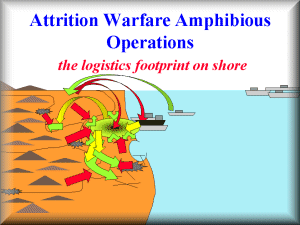 |
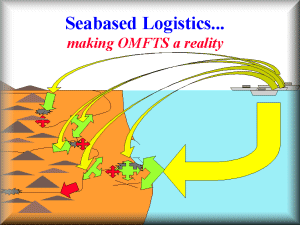 |
Click on images to enlarge
NEW POSSIBILITIES FOR LOGISTICS
Adopting best commercial practices, the functions of logistics will undergo a transformation to replace mass with information and speed. Total asset visibility will improve operational awareness of sustainment support, reduce logistics response time and permit logistics management by exception. Electronic transfer of requisitions, financial data, inventory records; , and access to worldwide inventories, will increase accuracy and speed critically needed information and supplies. Leveraging the over the horizon capabilities of aerial and surface lift assets, network based information technologies will enhance materiel distribution within tighter delivery schedules. Use of intermodal transshipment systems will increase materiel throughput and provide linkage to strategic lift and commercial distribution systems. Equipment and operational availability will increase with improved maintainability and increased reliability designed into new platforms and equipment to include predictive maintenance technology that employs embedded sensors to monitor wear and forecast repair part replacement.
The Tenets of Seabased Logistics
THE PRIMACY OF THE SEA BASE
The primacy of seabasing will be its ability to build, project, and sustain combat power.Seabased Logistics will employ an integrated over the horizon floating distribution center and workshop providing indefinite sustainment. Peacetime materiel readiness programs will maintain the current combat capability of afloat prepositioned equipment and supplies destined for the sea base. This tailorable capability will allow Commanders to shape combat power to match each contingency. While the primary fighting forces will carry initial support requirements, the sea base will provide credible long-term sustainment. Peacetime materiel readiness programs will maintain the current combat capability of afloat prepositioned equipment and supplies destined for the sea base.
Reducing or eliminating the logistics footprint on shore will be the primary thrust of Seabased Logistics. It will allow the logistics base to maneuver at sea with the operating forces. It will reduce double handling of materiel by cutting out the intermediate step of establishing shore-based logistics activities and eliminating the operational pause associated with that effort. Seabased Logistics will be employed when and where we choose and will not be subject to basing rights and host nation support. It will allow greater operational initiative and maneuver freedom. Forces ashore will not be required to protect massive logistics bases and extensive interior lines of communication. It will allow greater operational initiative and maneuver freedom.
Ship to Objective Logistics will minimize or eliminate the footprint on shore. Aerial delivery will replenish forces operating inland. Surface transport, carrying land mobile combat service support forces, will discharge a logistics trains that will operate with maneuver forces, then allowing lines of communication to close behind them. Replenishment of bulk fuel, water and supplies will be accomplished vertically or via surface transport on reopened ground supply routes. Caches of logistics support items will be established at selected locations for rendezvous with maneuver forces. Forward arming and refueling points (FARPs) will be established through aerial delivery or by mobile ground units deployed ashore. Loitering theater and strategic airlift will provide on-call airdrops of prepackaged resupply guided by global positioning system (GPS) steerable parafoils. Unmanned aerial vehicles offer the promise of expanded delivery options.
The ships of the sea base offer a tailorable mix of capabilities to perform varied missions and functions. Seabasing maintenance for both aviation and ground combat equipment will be critical to maintaining high optempo for extended periods and the ability to reconstitute equipment after an operation has been completed. The sea base will have access to spare parts through its sustainment network or by fabrication on site. Other special functions such as logistics over the shore systems, medical support, and specialized sustainment will be integrated as required. As future platforms are designed and fielded, legacy vessels can be adapted to Seabased Logistics for these functions.
REDUCING LOGISTICS DEMAND
Seabased Logistics will expand logistics reach, response, and optempo through reduced demand on available transportation and materiel resources. Continued improvements in operating efficiencies, equipment reliability, and precision ordnance and targeting, will reduce logistics demand. Alternative power sources and energy efficient systems will make significant reductions to sustainment requirements. Concurrently, the requirement to establish massive inventories of equipment and materiel ashore to ensure adequate support will dramatically change. Such buildups waste valuable time and resources as excessive inventories are received, staged, reissued, and forwarded to receiving units. In its place, maneuver warfare such as that envisioned by OMFTS will rely on the speed and agility vice attrition. Improved information technology and rapid distribution will reduce equipment and materiel stockpiled by logistics distribution systems and allow critical items to flow freely and directly to the end-user. The resultant decreased burden allows more fighting forces to be sustained ashore than would otherwise be supported.
OMFTS reduces or eliminates the footprint ashore. Command and control, combat service support and naval fires will be seabased. Placing logistics forces ashore afloat simplifies support and frees maneuver units from rear area security concerns. Seabasing Navy and Marine operational surface fires will radically reduce the requirement for ordnance and fuel ashore. Advanced FARPs will extend both air and ground operations. Use of a single fuel will enhance efficiency of operations ashore. With logistics resources more efficiently employed, the cumulative effect of demand reduction will be increased combat power and agility for rapid concentration of forces.
IN-STRIDE SUSTAINMENT
Highly automated requisition and distribution management systems reduce human input, accelerate materiel movement and reduce costs. Aggressive application of compatible commercial technology technologies will be used to anticipate demand. Instead of vast quantities of materiel (much of which may be of little use) being pushed forward, end-users will communicate consumption data that will pull tailored support to maneuver units. The highly automated nature of "anticipated pull" logistics will allow a management by exception approach. Enhanced knowledge of in-transit inventories through total asset visibility, will refine allocation of transportation resources, improve item availability and increase velocity of materiel movement through the system. This will allow lower inventory levels of inventory and better sustainment response. Since the dynamics of any situation can delay resupply or malposition resources amongst forward operating units, individual units will attach highly mobile, integrated combat service support elements that can carry minimal inventories and redistribute resources as required.
In-stride sustainment requires selective offload capability - the rapid retrieval and distribution of essential items from seabased storage. Selective offload will be the core of seabased support. The selective offload techniques used by the afloat sustainment platforms and amphibious shipping will be retained, expanded, and integrated with sustained operations ashore. Such techniques will include automated storage and retrieval technologies; package assembly areas; multiple vertical landing spots; capability to support lighterage; and the capability to receive or supply underway replenishment. The sea base will essentially serve as a primary distribution center with the capability to transship cargo from containers and distribute ready for issue containerized materiel cargo for distribution to to forces ashore. It will be comprised of station ships that deploy with a full load out and constantly receive and distribute various classes of supply. Unpredicted materiel demands and shortfalls will be met by shuttles with strategic and inter-theater lift, and worldwide commercial distribution systems.
ADAPTIVE RESPONSE & JOINT OPERATIONS
An adaptive logistics posture will respond to dynamic operational requirements. Seabased Logistics can support a broad range of military operations, to include humanitarian assistance and missions where ports and airfields are initially unavailable. As initial operations expand and sustainment demand exceeds the capacity of seabased support, Seabased Logistics will rely on expeditionary logistics support for flexible response. As aviation elements and other logistics intensive combat functions are established ashore, selected logistics support will follow. Expeditionary logistics sustained by the sea base will establish and maintain land bases for expanded operations and rapid closure of follow-on forces.
Sea-Based Logistics is part of the Theater Logistics effort. Seabased Logistics will be fully capable of integrating with Theater Logistics. Major joint operations ashore may require the establishment of selected shore-based logistics systems in support of maneuver forces. The sea base offers a feasible means to facilitate Joint Theater Logistics operations ashore. Seabased assets can be brought pierside or at anchorage to employ logistics over the shore capabilities and reduce transit times. However, OMFTS logistics will preferably remain seabased and ready for employment redeployment with supported forces.
FORCE CLOSURE & RECONSTITUTION AT SEA
The essence of force closure is generating combat power. By their very nature, naval forces lend themselves to rapid force closure and eliminate the requirement for land-based reception, staging, onward movement and integration operations. Seabased force closure is the at sea arrival, assembly, and integration of operational forces to realize their combat power and coordinate associated logistics sustainment. This eliminates the requirement for access to secure ports and airfields. Initial operational capability will be attained before engaging in combat and will then build additional combat power will grow with the assimilation of follow-on forces as they arrive in theater. Force closure may begin as part of a Maritime Prepositioning Force 2010 (MPF 2010) arrival and assembly operation and will take place primarily at sea.
The main thrust of the force closure process is the physical joining of military equipment, materiel, and manpower in a planned sequence, and where required to support the mission accomplishment. The instruments of force closure will be orchestrated within a cohesive strategy that deliberately integrates selected capabilities. Key to effective closure will be the integration of Amphibious Task Force, Combat Logistics Force, MPF 2010, Ready Reserve Force, and other Military Sealift Command elements designed for integration within the sea base. Seabased Logistics in its most robust form will enable total force closure at sea, thereby magnifying the power projection capabilities of naval forces. While the principal focus of Seabased Logistics is sustainment of operating forces, facilitating the build-up of amphibious combat power is well within its capability. As missions expand, Seabased Logistics can support the closure of joint and coalition forces arriving in theater.
As littoral operations enter new phases, Navy and Marine Corps Forces will have the unique capability to rapidly reconstitute at sea for redeployment to follow-on operations. Seabased Logistics will reduce the time required for reconstitution by retaining substantial command and control, fires, and logistics forces afloat throughout an operation. Advancements in maintenance, storage, distribution, and information technology will speed the retrograde of forces to the sea base. Rapid reconstitution of naval combat power will provide the Joint Force Commander with great flexibility to deal with emerging situations.
The ability of any force to reconstitute itself is a function of organic logistics capability and the interface with CONUS-based sustainment. With Seabased Logistics, both forces ashore and at sea will have in place the ability to recover equipment and personnel; decontaminate, salvage, dispose of equipment; perform intermediate level repairs; and pack, stow, and re-embark assets as appropriate. The interface with CONUS-based strategic pipelines will replenish personnel, equipment, ordnance, and initial sustainment supplies and will retrograde hazardous wastes, ordnance needing service, and salvaged equipment.
The sea base must have intermediate maintenance capability for organic combat equipment and to support reconstituted naval forces. Maintenance operations will be enhanced by predictive maintenance technologies, rapid replenishment of spares directly from manufacturers, and an on site spares fabrication capability. Equipment salvage operations will include the rapid recovery of combat damaged and deadlined equipment for decontamination and triage by mobile maintenance units during return to the sea base. Equipment requiring depot level maintenance will be returned to intermediate staging bases or CONUS.
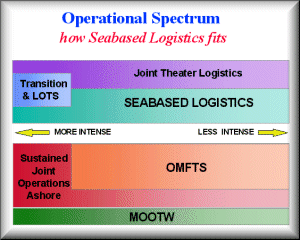 |
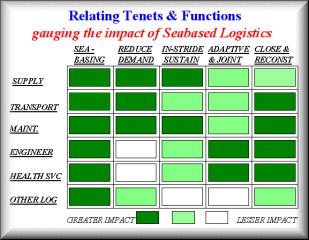 |
Click on images to enlarge
Functional Areas of Seabased Logistics
SUPPLY & SUSTAINMENT
Receive, store, issue, and resupply materiel for Naval operations. The sea base will be the focus of a logistics information and distribution system that manages integrated and tailored loadouts. The system may employ information technology that automatically notifies theater and strategic supply sources that replenishment will be needed as items are issued from seabased stock. The automated process will require monitoring and periodic adjustment only when conditions change. Unforecasted supply requirements will be pulled to the sea base or distributed directly to requesting units. System implementation will demand a seamless, commercially compatible, and interoperable information system that tracks items from origin to end-user.
TRANSPORTATION & DISTRIBUTION
Movement of units, personnel, equipment, and supplies from the point of origin to final destination. Distribution is the keystone of Seabased Logistics. Managing finite lift resources to satisfy the broad range of operational and logistics missions will require close coordination. Indefinite sustainment of operating forces and sea base replenishment may employ theater intermediate support bases and commercial distribution hubs. To assure end-user delivery, ship to objective distribution systems will employ deception, military firepower, and maneuverability to counter known threats.
MAINTENANCE
Actions necessary to preserve, repair, and ensure continued operation and effectiveness of weapon system combat readiness. An integral function of Seabased Logistics will be the ability to perform organizational and intermediate level maintenance at sea. Equipment with embedded sensing devices and on board diagnostics will permit accurate fault isolation and repair parts delivery for corrective maintenance. Spares inventory will be refined by reliability centered maintenance, on low maintenance engineering designs, express delivery systems, and advanced, on-site shipboard fabrication and manufacturing technologies. Electronic reachback to manufacturer inventories and design databases will facilitate repairs within the sea base.
ENGINEERING
Planning, design, construction, maintenance, and battle damage repair of infrastructure. A seabased expeditionary engineering capability is a key to supporting arrival and assembly of shore-based follow-on forces and enabling continued Seabased Logistics support of OMFTS missions. Seabased engineering will provide flexible support to post-conflict termination missions including refugee support, enemy prisoner of war control, infrastructure restoration and humanitarian relief.
HEALTH SERVICE SUPPORT
Support the health of the military force. Expeditionary casualty care for the 21st Century is founded on the principles of a healthy and fit force; , casualty prevention; , and capability based casualty care and management. Battle casualties will be handled using rapid stabilization, far-forward surgery, essential care and hospitalization in theater, and rapid evacuation out of theater to more definitive levels of care as defined by theater evacuation policies. The concept requires modernized en-route care and total in-transit visibility of casualties. The focus of medical capability levels is based on time and clinical capability, vice personnel or medical treatment location.
Seabased Logistics Planning and Information Support
PLANNING FOR SEABASED LOGISTICS
Logistics is integral to warfighting. The OMFTS environment demands the full integration of combat operations and Seabased Logistics. Course of action development and associated concepts of employment will require team planning with the battle staff to ensure that distribution resources are appropriately assigned to support seabased command and control, fires, maneuver, logistics and force protection. Seabased Logistics will demand a balance between resources and mission requirements to ensure operations can be sustained. It will likewise require carefully coordinated strategic and operational lift operating within the sea base.
The significant challenge of planning bulk liquid support will require focused management and demand reduction. Sustaining fuel and water to mobile forces will absorb large portions of seabased distribution capabilities. Providing this critical operational support may require a combination of mobile combat service support elements, air delivered stocks, or developing temporary forward arming and refueling points. With enhanced energy efficiencies and alternative power systems, and by altering the mix of forces projected ashore, sizeable reductions in fuel consumption can be achieved.
SEABASED LOGISTICS INFORMATION SUPPORT
Command and control of Seabased Logistics will be an inherent aspect of the operational command and control process - no separate organization is envisaged. Seabased Logistics will be both a command function and an operational capability. The Navy and Marine Corps will partner in efforts to sustain the sea base and provide ship to objective logistics. Information management will be the backbone of a coordinated approach to Seabased Logistics command and control. The command, control, communications, computers, and intelligence features organic to the sea base will permit precise voice, data, and video transmission capabilities interfaced with tactical, intelligence, and weather data systems, to enhance in-stride sustainment of combat forces on the move. Real-time monitoring of ordnance, fuel, and supply consumption will forecast demand and facilitate preparations for pre-planned resupply operations.
Seabased Logistics will employ the same information systems as Joint Theater Distribution. Seabased Logistics information requirements will fully interface with the Global Combat Support System (GCSS) and commercial asset visibility systems. Once fully employed and integrated with all strategic and theater distribution networks, GCSS will serve as a communications framework for monitoring consumption rates and coordinating sustainment operations.
Summary
Seabased Logistics will be the operational and tactical sustainment process for naval maneuver warfare. The tenets of Seabased Logistics (sea base primacy, demand reduction, in-stride sustainment, adaptive response and joint operations capable, ability to close and reconstitute forces at sea) employ improved logistics tactics, techniques, and procedures to deliver flexible, highly responsive support for future naval and joint operations. Force closure and reconstitution at sea will expand force employment options well beyond what is capable today. The sea base will not be one vessel or platform, but a tailorable mix of ships delivering specialized support and sustainment to an integrated force.
|
Essential Future Operational Capabilities
|
Relevance of Maritime Forces. As it is today, the relevance of Naval forces in the future will be founded on employability by the warfighting Commanders-in-Chief, and maritime forward presence will continue to be the principal means to achieve that end. Maritime forward presence is performance proven in support of our maritime nation, and that presence requires a credible organic sustainment capability. Maritime forward presence is a key to developing future Navy and Marine Corps operating force structure, and Seabased Logistics will be a principal underwriter of the tangible credibility necessary for the CINCs to view the Navy-Marine Corps team as the 21st Century force of choice.